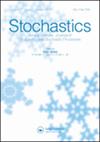关于跳跃大小和对冲的信息
IF 0.9
4区 数学
Q3 MATHEMATICS, APPLIED
Stochastics-An International Journal of Probability and Stochastic Processes
Pub Date : 2014-10-24
DOI:10.1080/17442508.2014.895356
引用次数: 4
摘要
我们研究一个市场中的对冲问题,在这个市场中交易者有不同程度的信息。只有知情交易者才能获得的独家信息是通过扩散过程而不是新信息的离散到达来建模的。资产价格遵循跳跃-扩散过程,信息过程影响资产价格的跳跃大小。我们找到了知情交易者的局部风险最小化对冲策略。通过蒙特卡罗给出了数值例子,并与Black-Scholes策略进行了比较。本文章由计算机程序翻译,如有差异,请以英文原文为准。
Information on jump sizes and hedging
We study a hedging problem in a market where traders have various levels of information. The exclusive information available only to informed traders is modelled by a diffusion process rather than discrete arrivals of new information. The asset price follows a jump–diffusion process and an information process affects jump sizes of the asset price. We find the local risk minimization hedging strategy of informed traders. Numerical examples as well as their comparison with the Black–Scholes strategy are provided via Monte Carlo.
求助全文
通过发布文献求助,成功后即可免费获取论文全文。
去求助
来源期刊

Stochastics-An International Journal of Probability and Stochastic Processes
MATHEMATICS, APPLIED-STATISTICS & PROBABILITY
CiteScore
1.90
自引率
0.00%
发文量
42
审稿时长
>12 weeks
期刊介绍:
Stochastics: An International Journal of Probability and Stochastic Processes is a world-leading journal publishing research concerned with stochastic processes and their applications in the modelling, analysis and optimization of stochastic systems, i.e. processes characterized both by temporal or spatial evolution and by the presence of random effects.
Articles are published dealing with all aspects of stochastic systems analysis, characterization problems, stochastic modelling and identification, optimization, filtering and control and with related questions in the theory of stochastic processes. The journal also solicits papers dealing with significant applications of stochastic process theory to problems in engineering systems, the physical and life sciences, economics and other areas. Proposals for special issues in cutting-edge areas are welcome and should be directed to the Editor-in-Chief who will review accordingly.
In recent years there has been a growing interaction between current research in probability theory and problems in stochastic systems. The objective of Stochastics is to encourage this trend, promoting an awareness of the latest theoretical developments on the one hand and of mathematical problems arising in applications on the other.
 求助内容:
求助内容: 应助结果提醒方式:
应助结果提醒方式:


